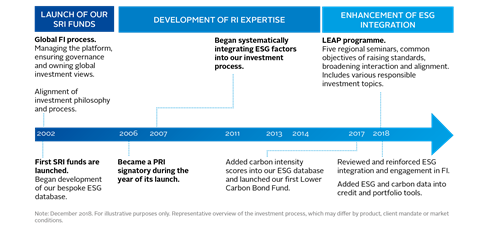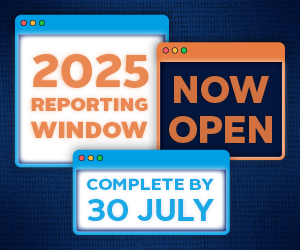Case study by HSBC Global Asset Management
| Authors | Xavier Baraton, Global Chief Investment Officer, FI & Alternatives; and Helene Winch, Senior FI Responsible Investment Advisor |
|---|---|
|
Market participant |
Asset Manager |
|
Total AUM |
US$460.7 billion (as at September 2018) |
|
FI AUM |
US$185.9 billion (as at September 2018) |
|
Operating country |
Global |
Action areas:
- Organisational approach
- Communication and transparency
The investment approach
We believe that ESG issues can have a long-term material impact on company fundamentals, and that they are linked to opportunities and risks which financial markets may not price appropriately.
The integration of ESG factors within our investment process is led by the FI investment team and is not a standalone process. The team comprises 177 members who rely on the support of the Global Credit Research platform, comprising 46 sector and regional analysts including 11 ESG champions, and a separate team of ESG specialists who support the process by providing ESG data, sector knowledge and thematic research.
The current approach is the result of a process (see below) starting in 2002 with the launch of our first sustainable fund. We integrated ESG factors more systematically across our FI process starting in 2007, using external ESG data providers for our research and analysis.

Taking the learnings from managing successful sustainable funds, backed by analytical research showing that considering ESG factors is beneficial to the investment process and rarely has a negative impact, we reviewed our process in 2017 and subsequently reinforced our ESG integration and engagement process. This involved the launch of a FI ESG thematic “university” to promote awareness, training and guidance on ESG subject matter, and recruiting a dedicated FI responsible investment advisor.
The investment process
The investment process starts with the selection of our investment universe, involving issuer-level screening in line with our controversial weapons exclusion policy and any other client or strategy exclusions.
We then consider the composite ESG score and summary for each issuer provided by our global ESG database, using data from third-party ESG data providers. The highest-risk names per sector (categorised by emerging and developed markets) are highlighted in the database and require a more detailed level of due diligence by the credit research team before any investment.
Our fundamental research framework for all companies incorporates ESG analysis as specific inputs, including a business profile detailing components of management, governance and strategy, and liabilities (legal, social and environmental). This analysis highlights – firstly and most importantly – any potential negative impacts on the operating profile of the company and, secondly, financial metrics such as revenue and debt/EBITDA. This is supplemented with issuer meetings by the credit research team where further ESG questions specific to the issuer or sector are raised.
CRA reports and external ratings are one of many inputs into our credit analysis, but we do not rely solely on them; in fact, we produce our own proprietary credit ratings. However, we use external credit ratings to define investment universes for funds and mandates. They are also among the second-party certifiers of green bonds we use for green bond assessment.
The credit process ensures we only select issuers whose operating and financial metrics we are comfortable with and exclude those that are viewed as unreliable or have potential idiosyncratic risks. The credit analyst approves each issuer with oversight from the Global Head of Credit Research.
Credit analysts communicate directly with their investment colleagues globally at sector and country level as well as through groups such as the ESG Analyst Group that communicates and shares ESG sector-level research, investment views and engagement findings between analysts in the credit and equity teams. One of the group’s main outputs of 2018 was the production of 24 ESG sector checklists, summarising each industry’s ESG issues and suggesting engagement questions, enabling analysts to focus on the most financially-material dimensions for credit. We monitor engagement activities on a quarterly basis, covering the contact that we have with issuers to ensure that we raise ESG-related questions with them and share our findings across the investment platform. We also monitor funds’ ESG and carbon intensity scores, providing feedback into the portfolio construction process (see below).
One of the main challenges in integrating ESG factors in FI is data availability, partly due to the dominance of data providers using equity indicators. All ESG data needs to be mapped internally to our issuer universe. Coverage of unlisted or sovereign-owned enterprises has yet to be developed.

The investment outcomes
As part of the fundamental credit process, we require a full understanding of the balance sheet including any potential ESG risks that could impact cash flow, debt/EBITDA and other credit metrics. For privately-held companies, the required financial and ESG information is often unavailable or insufficient to complete a credit review. When this happens, we engage with the issuer, requesting information from the treasurer, CFO or investor relations team.
In a recent example concerning a European unlisted company (with an external credit rating of AA and a low governance rating by an ESG service provider), we were unable to confirm the existence of policies related to anti-corruption. This information was required to complete the liabilities (legal, social and environmental) component of our credit analysis and was potentially financially material due to the issuer’s high level of government-regulated income and involvement with government procurement. We contacted the company and spoke with the treasurer in 2017, when we requested the required policy. The company understood our requirements and agreed to disclose the policy. We were able to approve the credit and invest in its upcoming bond issue.
In another example, in the European unlisted market, a corporate with a complex financial structure and limited public disclosure meant we were unable to form a comprehensive view on the credit. This led to uncertainty about the potential for stable future cash flows and credit metrics. We attempted several engagements with company management to mitigate these concerns, which were unsuccessful and therefore further amplified our concerns. As a result, we felt that this risk was not being priced into the company’s bonds. Based on this limited information, we internally downgraded the credit, and informed the company that we would not be able to participate in any new issues unless it increased its willingness to engage with debt investors.
In both examples, we also considered carbon risk in our credit analysis. However, given the lack of carbon intensity disclosure data in the unlisted corporate market, we are unable to complete our carbon risk calculations and may be increasingly restricted in the size of positions we can hold.
Key takeaways
Although we have been integrating ESG in our investment process for many years, the PRI’s workstreams on FI and on CRAs has highlighted the requirements for clearer explanations of the investment process, particularly in how we consider ESG data and risks and opportunities in our credit research process, as well as the importance of issuer engagement.
Our recent enhancements have increased ESG knowledge and dialogue within the investment team, leading to better evidence of our ESG integration process to clients. We are also planning to introduce a public quarterly report on integrating ESG in FI to enhance our transparency.
Within our propriety tools, we can measure the outcome of our ESG integration through improved portfolio ESG and carbon scores. We believe this will lead to more sustainable risk-adjusted returns for clients in the long term.
Future plans include systematically embedding sector-specific ESG criteria directly into proprietary quantitative credit ratings. This will further enhance our ability to consider ESG data in the credit process.
Download the report
-

Shifting perceptions: ESG, credit risk and ratings: part 3 - from disconnects to action areas
January 2019
ESG, credit risk and ratings: part 3 - from disconnects to action areas
- 1
- 2
- 3
- 4
- 5
- 6
- 7
- 8
- 9
- 10
- 11
- 12
- 13
- 14
 Currently reading
Currently readingCase study: HSBC Global Asset Management
- 15
- 16
- 17
- 18
- 19
- 20
- 21
- 22
- 23
- 24
- 25


































